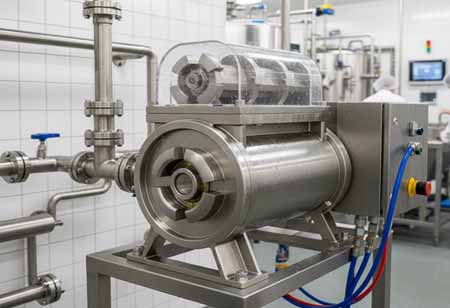THANK YOU FOR SUBSCRIBING
Be first to read the latest tech news, Industry Leader's Insights, and CIO interviews of medium and large enterprises exclusively from Food and Beverage Tech Review
Twin Screw Pumps as Strategic Enablers of Product Integrity and Operational Excellence
The twin screw pump enhances food manufacturing by ensuring gentle product handling, operational efficiency, and hygienic processing, making it essential for maintaining quality and integrity in food products.

By
Food and Beverages Tech Review | Friday, October 10, 2025
Stay ahead of the industry with exclusive feature stories on the top companies, expert insights and the latest news delivered straight to your inbox. Subscribe today.
The twin screw pump has transformed from a basic material mover into a strategic cornerstone of modern food manufacturing through its advanced design and versatile functionality. In an industry driven by demands for higher product quality, operational efficiency, and uncompromising hygiene, the twin screw pump provides a decisive advantage, fundamentally reshaping how processors handle everything from delicate dairy products to viscous fruit preparations. This rise to prominence is not accidental but a direct result of its unique ability to combine gentle product handling with robust operational performance, making it an indispensable tool for food producers aiming to innovate and excel.
Unpacking the Twin Screw Design
At the heart of the twin screw pump's success is its elegant and practical mechanical design. Unlike many other positive displacement pumps, it utilizes two intermeshing screws that rotate within a precisely machined housing. These screws, often with a variable pitch, turn in opposite directions, creating enclosed chambers that move axially from the suction side to the discharge side of the pump. This ensures a continuous and smooth transfer of the product. The key is that the screws do not come into contact with each other or with the pump casing. This non-contacting architecture is fundamental to its performance in hygienic applications.
This design enables the handling of a comprehensive range of fluids with a single pump. It can efficiently transfer low-viscosity liquids, such as milk or juice, just as easily as it can handle high-viscosity pastes, like tomato concentrate or caramel. Furthermore, it excels at pumping shear-sensitive products containing soft solids or delicate particulates, like fruit-in-yogurt, pie fillings, or curds. The gentle, axial conveyance ensures these inclusions are transferred without damage, preserving the texture and appearance of the final product. The pumping action can be likened to a continuously moving, sealed pocket, which carefully carries the product forward without crushing or agitating it. The result is a pulsation-free flow, a critical feature that eliminates pressure variations and ensures a consistent, steady output. This inherent versatility enables food processors to utilize a single pump for multiple products, simplifying line design and reducing the need for a diverse inventory of specialized equipment.
How Twin Screw Pumps Enhance Product Quality and Integrity
The strategic value of a twin screw pump lies in its ability to do more than just move product; it actively protects and enhances product quality. The low-shear characteristic derived from its non-contacting design is paramount. In food processing, shear is the force that can break down emulsions, damage cellular structures, and alter the viscosity and mouthfeel of a product. For example, when pumping delicate sauces or dairy products, high shear can lead to a loss of texture and separation of ingredients. The gentle action of a twin screw pump minimizes this stress, preserving the intended structure and sensory profile of the foodstuff. This means yogurts remain creamy, fruit pieces stay whole, and emulsions remain stable, leading to a premium end product that meets consumer expectations for quality and consistency.
The pulsation-free discharge delivered by the twin screw mechanism has significant downstream benefits. In applications such as filling and dosing, a smooth, constant flow is essential for accuracy and repeatability. Pulsations can cause inconsistencies in package weights, leading to product giveaway or non-compliance with labeling regulations. By providing a steady, linear flow, twin screw pumps enable precise portion control, minimizing waste and improving the efficiency of packaging lines. This level of control is not just about cost savings; it's also about maintaining a strong brand reputation. A consumer who receives a consistently filled package is more likely to trust the brand. This direct impact on product integrity and packaging precision is a clear example of how the pump has transitioned from a mere utility to a critical component in the quality assurance chain.
The Dual-Duty Advantage and Hygienic Superiority
A defining feature that elevates the twin screw pump to a strategic asset is its remarkable dual-duty capability. Many designs can operate at both low speeds for gentle product transfer and high speeds for Cleaning-in-Place (CIP) protocols. This hybrid functionality is a game-changer for plant efficiency. By running at high rotational speeds, the pump can generate the high flow rates and fluid velocities required to effectively clean pipes and processing equipment effectively, often meeting the standard of 1.5 meters per second (1.5 m/s) required for turbulent flow. This eliminates the need for a separate, parallel CIP pump and the associated bypass lines, valves, and complex controls.
This consolidation delivers significant benefits. It reduces the initial capital investment, simplifies the overall system design, and shrinks the equipment's physical footprint, freeing up valuable floor space in the processing plant. Operationally, it streamlines the cleaning process, reducing changeover times between production runs and increasing overall equipment effectiveness (OEE). Beyond its dual-duty function, the pump is engineered from the ground up for hygienic processing. Typically constructed from 316L stainless steel with highly polished surfaces, it is designed to be self-draining and free of crevices or dead zones where product can accumulate and harbor bacteria. These pumps are designed to meet the world's most stringent hygienic standards, including those from the 3-A Sanitary Standards and the European Hygienic Engineering & Design Group (EHEDG), ensuring they are not only efficient but also intrinsically safe for food contact. This combination of operational streamlining and uncompromising hygienic design makes the twin screw pump a powerful tool for optimizing production while guaranteeing food safety.
The twin screw pump stands as a testament to innovation in food manufacturing, merging advanced engineering with practical application to deliver superior product quality and operational efficiency. As food processors continue to face the ever-evolving demands of consumers for higher quality and safety standards, the twin screw pump emerges as an indispensable asset in their operational arsenal. Ultimately, its role in modern food processing reaffirms the impact of thoughtful engineering in creating reliable solutions that respond to the complexities of today's food industry.
I agree We use cookies on this website to enhance your user experience. By clicking any link on this page you are giving your consent for us to set cookies. More info







